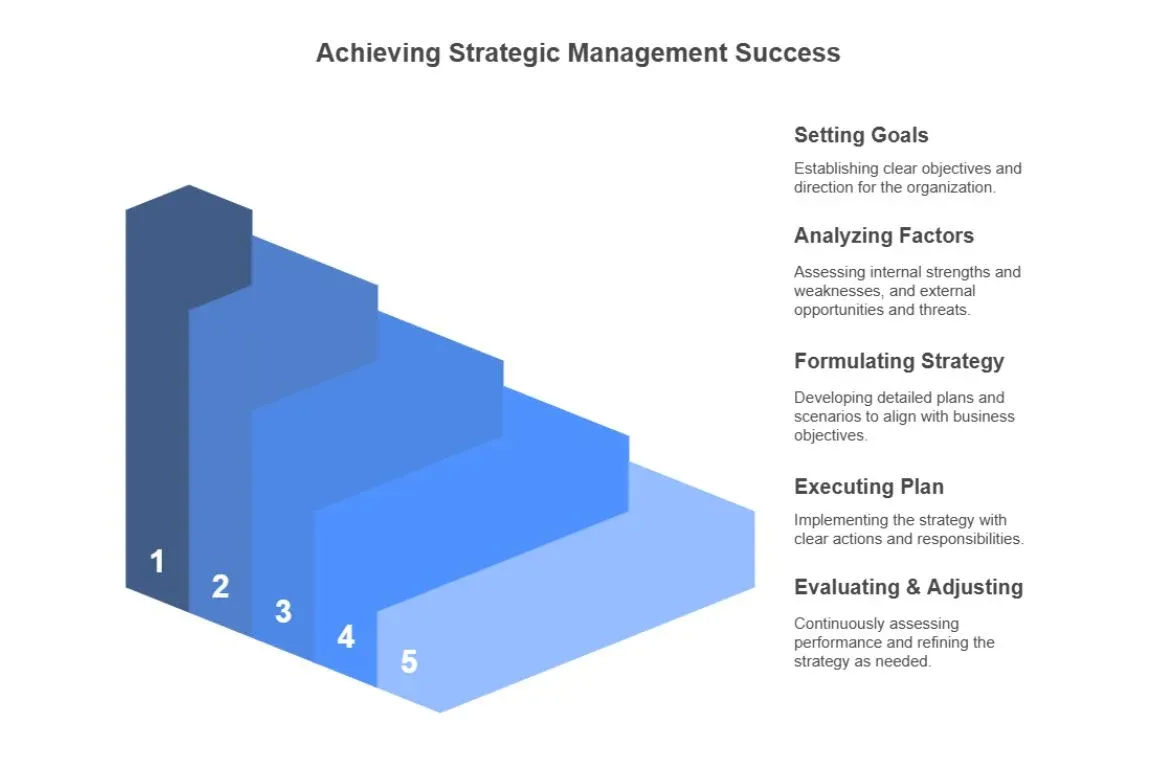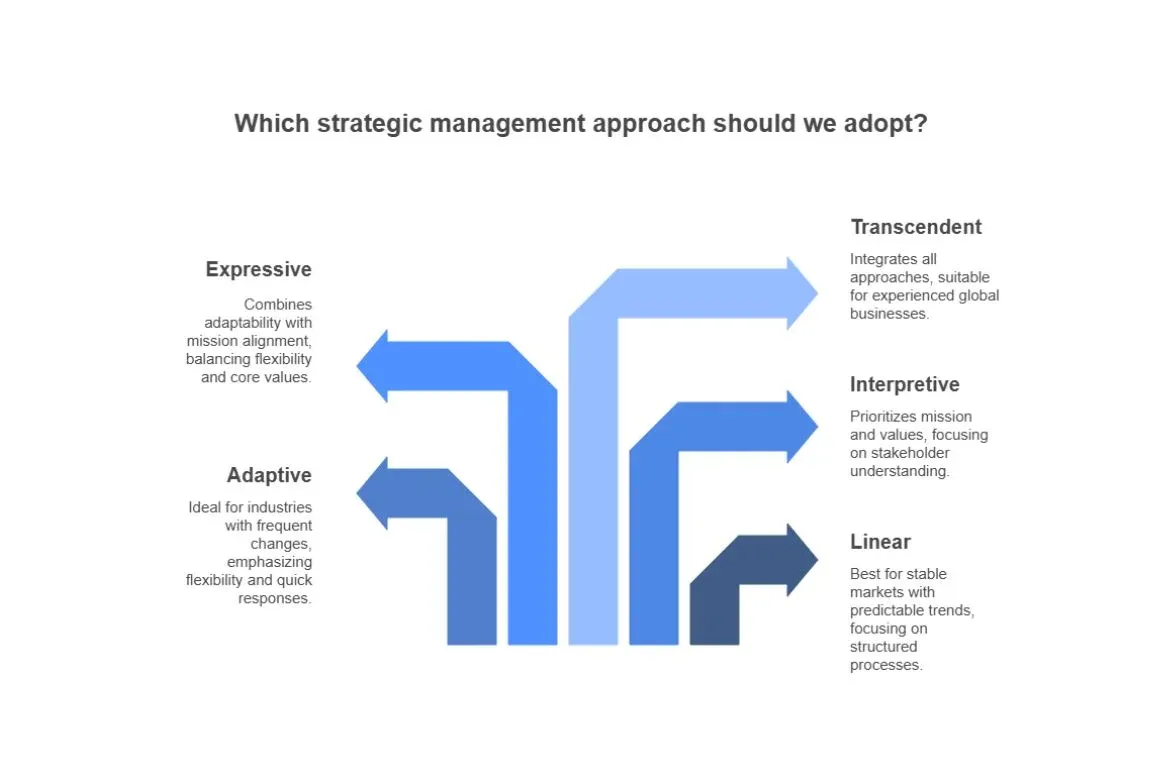What Is Strategic Management and What Are Its Types?

Strategic management has become the most in-demand skill in today's business world. It surpasses other management disciplines in job opportunities. Organizations use this systematic approach to turn their visions into practical steps that boost market share, revenue, and risk management.
Organizations of all types need strategic management to set and reach their goals. The path to success follows five key steps: identification, analysis, formation, execution, and evaluation. These steps create a well-laid-out roadmap to achieve organizational success.
This complete guide dives into strategic management's meaning, types, and features that drive modern business success. You'll discover five unique approaches to strategic management and learn to apply them in your organization.
What is Strategic Management?
Strategic management is a systematic process to plan, implement, and evaluate long-term organizational decisions. Strategic management serves as the foundation of an organization's future direction. It helps create and execute major objectives based on what the company can do and what's happening in the external environment.
Definition and core purpose
Strategic management helps organizations create, implement, and evaluate their long-term goals. It gives companies a blueprint to make decisions that will shape their future. The main goal goes beyond daily operations. Companies think over their plans and allocate resources to create lasting competitive advantages.
This approach combines a company's mission, vision, and values with market realities and business needs. Companies gather information about external factors like market forces, government rules, and what consumers want. They also look at internal factors such as their team's skills, structure, and budgets to make better decisions.
Why it matters in modern business?
Companies started using strategic management when market competition made them pay more attention to the business environment. Organizations that use good strategic management get several important benefits:
- Clear direction through defined vision, mission, and goals
- Better decisions through analytical insights
- More efficient use of resources
- Unique ways to stay ahead of competitors
- Good balance between quick wins and future growth
Strategic management helps companies adapt to change in today's fast-moving business world. They can keep their market position and grow steadily. Teams work better together toward common goals when everyone understands the strategy.
Strategic management vs. regular management
People often mix them up, but strategic management is different from regular management. Strategic management looks at long-term goals and where the organization is heading. Regular management coordinates daily business tasks to meet immediate goals.
Regular management focuses on operations. Managers work to control costs and stay efficient within the strategy's boundaries. Strategic management takes a wider view. It answers big questions like "what is our business?" and finds the organization's place in the competitive landscape.
The difference becomes clear when we look at what each does. Operational managers put strategies to work by assigning people and tools. Financial managers handle the money. HR managers follow the rules. Strategic management creates the big picture that guides all these functions.
The 5-Step Strategic Management Process
Strategic management success depends on a well-defined process with five key steps. Each step builds on the previous one. This creates a framework that changes organizational vision into measurable results.

1. Setting goals and direction
Clear goal-setting forms the foundation of strategic management. The original stage defines an organization's mission, vision, and specific business objectives. These provide direction throughout the strategic cycle. Leaders must set top-level objectives related to growth, market position, or desired business outcomes.
Organizations should develop SMART goals—Specific, Measurable, Achievable, Relevant, and Time-bound. These objectives act as a compass for all strategic activities and help everyone understand what success means.
2. Analyzing internal and external factors
A full picture of both internal capabilities and external environment becomes critical after setting goals. This step helps teams learn about the organization's strengths and weaknesses along with market opportunities and threats.
Companies assess their core competencies, unique advantages, and resource gaps through internal analysis. External analysis looks at market trends, customer needs, emerging technologies, competitive pressures, and economic changes. This analysis also reveals operational inefficiencies, employee morale problems, and financial constraints that might affect strategy.
3. Formulating the strategy
Organizations develop strategic plans based on what they learned during analysis. Teams evaluate different strategic paths, select approaches that line up with business objectives, and use organizational strengths. Creating detailed plans with actions, timelines, and resources becomes essential. Teams should think over various scenarios and prepare backup plans to handle potential challenges.
4. Executing the plan
Strategy execution stands as the most challenging step that puts plans into action. Teams must break down strategic plans into specific actions with clear responsibilities and timelines. On top of that, cross-departmental collaboration and smart resource allocation support effective implementation.
5. Evaluating and adjusting
The final step focuses on continuous assessment and refinement. Organizations must review their strategy's performance regularly. They use metrics and KPIs to measure progress toward goals. This ongoing evaluation helps spot issues, make needed adjustments, and improve execution.
Types of Strategic Management Explained
Organizations use strategic management in different ways based on their environment, culture, and goals. Leaders need to understand both the five-step process and various types of strategic management. This knowledge helps them pick approaches that work best for their specific business situations.

Linear: structured and logic-based
Linear strategic management stands as the most traditional approach that relies on logical and rational decision-making processes. The methodology moves in a clear sequence where strategy creation, implementation, and review happen in a predictable order. Companies that use this approach start by analyzing their strengths and weaknesses to spot potential challenges. They create structured responses to competitive pressures and focus on better marketing, sales strategies, and customer service instead of changing their core products. This method works best in stable markets where future trends stay predictable.
Adaptive: flexible and iterative
Adaptive strategic management takes a different path from linear strategies by embracing flexibility and constant improvement. Companies can respond quickly to unexpected market changes with this approach. These strategies focus on temporary advantages rather than long-term competitive edges. Companies test, review, and improve their strategies constantly. This works really well in industries with frequent tech breakthroughs or changing customer behaviors. About two-thirds of industries now face high uncertainty in demand, competition rankings, and profits, which makes this approach more relevant than ever.
Interpretive: values-driven decision-making
Interpretive strategic management puts the company's mission and values first when making decisions. This method focuses on understanding what stakeholders think and how company culture shapes strategy. Though less common than other types, this approach sees strategy as an evolving process rather than a fixed structure. Companies get better results when new projects line up with their overall goals by adapting to market insights. Organizations that use this method put their brand integrity and cultural unity first when making strategic choices.
Expressive: proactive and mission-aligned
Expressive strategic management cleverly combines both adaptive and interpretive approaches. This evolved method prioritizes quick responses to environmental changes while staying true to the organization's mission and vision. It's harder to get right, but this approach balances flexibility with a steadfast dedication to core values. Companies that master this method can take advantage of new market trends while keeping their identity and purpose intact.
Transcendent: integrated and holistic
Transcendent strategic management sits at the top of strategic sophistication by using strengths from all other types. Companies usually adopt this detailed approach after they've mastered the other four strategies. They create a unique, multi-faceted strategy that makes use of different management styles to handle complex challenges effectively. This integrated approach works particularly well for 10-year-old businesses with lots of strategic planning experience, especially those competing globally.
Key Characteristics of Strategic Management
Organizations need to understand what makes strategic management unique to implement it well. This management approach differs from traditional methods in several key ways.
Looking ahead, not just at today
Strategic management looks beyond quick wins to focus on long-term success. Leaders must spot trends and prepare for challenges that could emerge years from now. They need to make decisions that will work even as markets change and become unpredictable. Smart organizations take a proactive approach to handle future opportunities and threats. This longer view lets businesses tackle issues that might not seem urgent today but could become critical tomorrow.
Leadership from the top down
Senior leaders must drive strategy implementation. They have a broad view to understand how strategic decisions ripple through the organization and the power to direct resources where needed. These leaders are vital links between the company's vision and its day-to-day operations. Their buy-in motivates the whole organization to make better strategic choices. The quality of leadership shapes both how strategies form and how well they work.
Changes that touch everyone
Strategic decisions create ripples throughout the organization. These choices affect everything from customer relationships to competitive focus and structure. One big advantage comes when employees unite behind a shared vision with clear goals. Teams can then make decisions that support long-term objectives across departments. Strategic management helps organizations grow by matching resources with goals while adapting to external changes.
Always measuring, always improving
Success demands a solid system to track progress. Regular assessment spots problems and updates strategies as conditions shift. Good evaluation needs more than just KPIs - it requires a consistent rhythm to measure progress. Organizations should keep close watch on key metrics and be ready to adjust quickly. Regular check-ins and strategy reviews ensure the plan stays on track and evolves when needed.
Conclusion
Strategic management is the lifeblood of organizational success, combining systematic planning with adaptable execution. Organizations become skilled at this practice and gain the most important advantages through clearer direction, better resource allocation, and improved decision-making capabilities.
The role of strategic management is growing rapidly. The significance of strategic management in today's dynamic landscape is undeniable. Guiding organizational direction, fostering competitive advantage, and ensuring long-term success, strategic thinking is paramount across all industries.
Discover why strategic management is vital for company success and explore rewarding career paths in this essential business function. Explore the top-notch business management courses offered by TalentSprint in association with prestigious management institutions in India.
Shape business direction and gain a rewarding career in strategic management. Learn from industry leaders and top universities to build or advance your skills!
FREQUENTLY ASKED QUESTIONS
1. What do you mean by strategic management?
It's the process of formulating, implementing, and evaluating cross-functional decisions that enables an organization to achieve its objectives.
2. What are the 5 stages of strategic management?
The 5 stages of strategic management typically include: Goal Setting, defining objectives; Analysis, evaluating internal and external environments; Strategy Formulation, developing strategic options; Strategy Implementation, putting plans into action; and Strategy Evaluation & Control, monitoring progress and making adjustments.
3. What are the 5 P's of strategy?
The 5 P's offer varied lenses on strategy. Plan is a deliberate course of action. Ploy is a specific tactic to outmaneuver rivals. Pattern emerges from consistent actions. Position defines how the organization situates itself in the market. Perspective represents the shared mindset shaping strategic direction. These collectively provide a holistic view.
4. What is a concept in strategic management?
A concept in strategic management is a fundamental idea or framework that helps in understanding and guiding strategic thinking and action within an organization.

TalentSprint
TalentSprint is a leading deep-tech education company. It partners with esteemed academic institutions and global corporations to offer advanced learning programs in deep-tech, management, and emerging technologies. Known for its high-impact programs co-created with think tanks and experts, TalentSprint blends academic expertise with practical industry experience.



